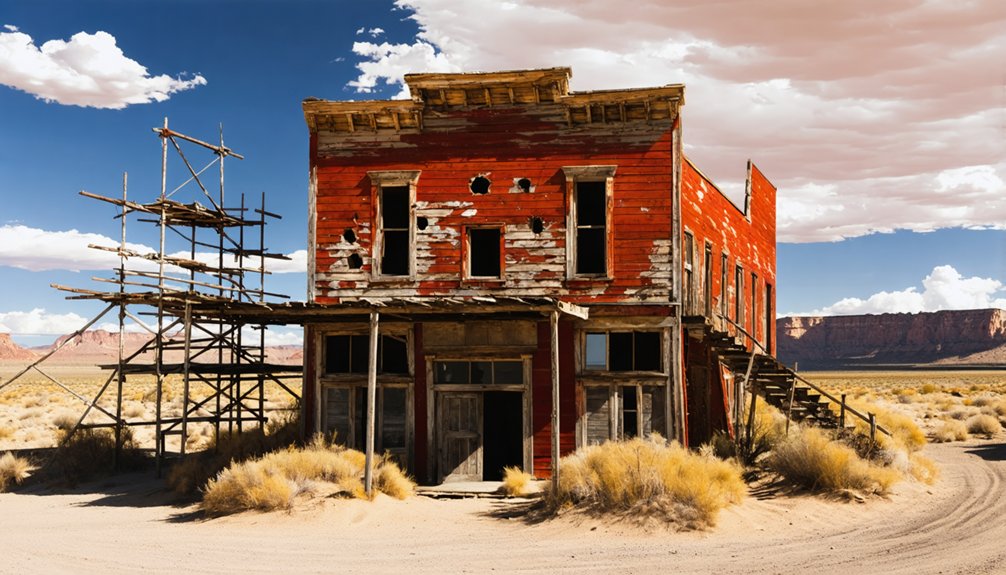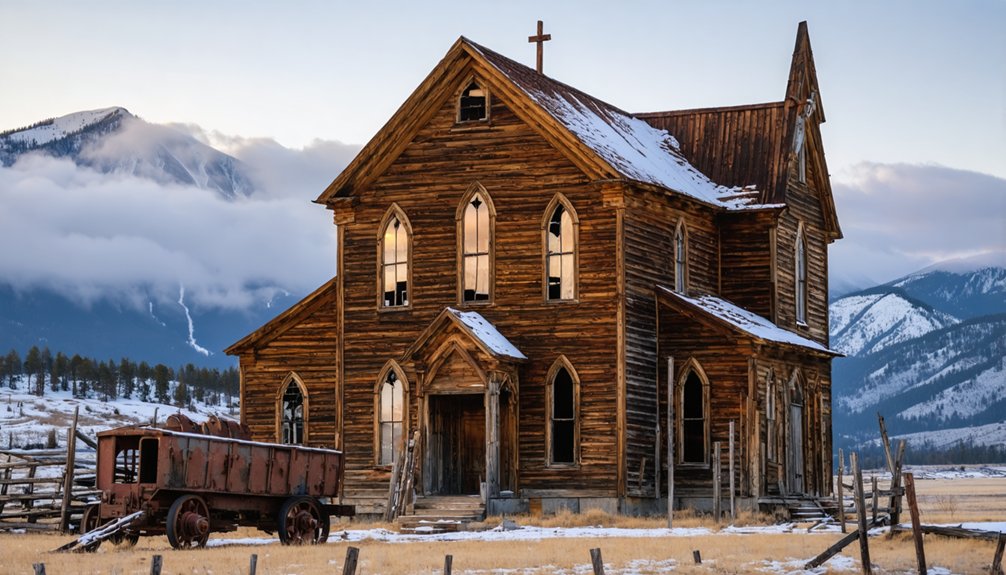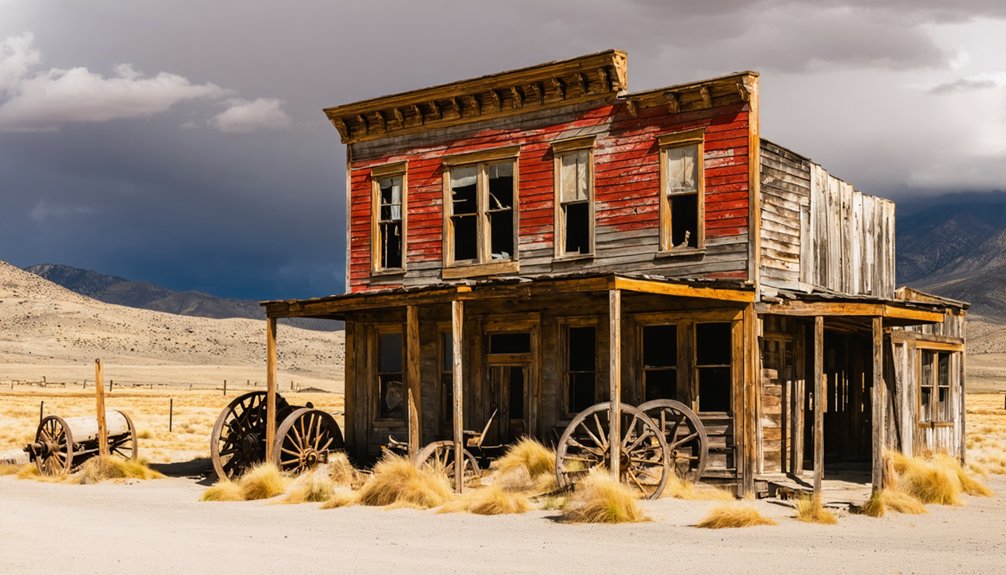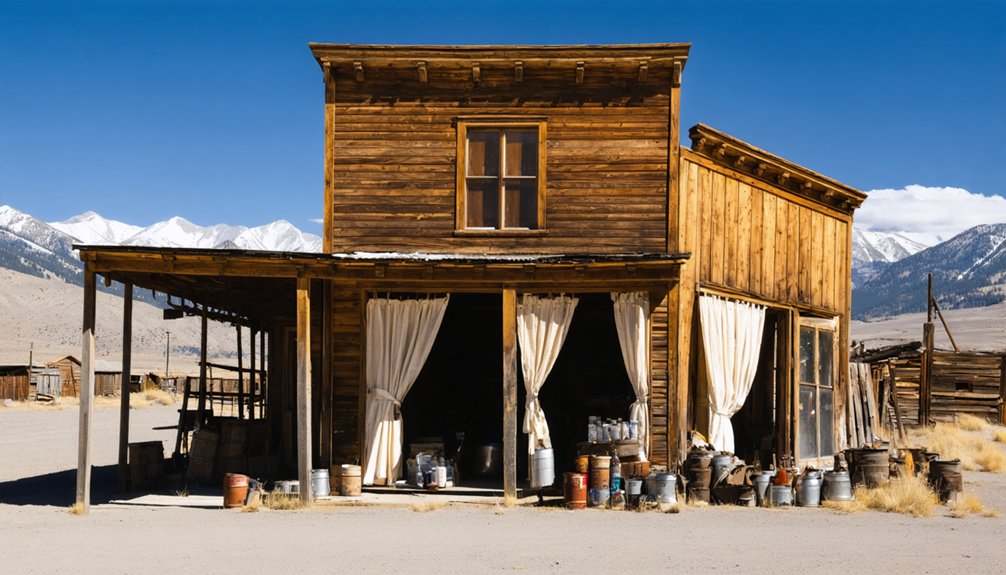You’ll discover America’s most enchanting ghost towns in the remote reaches of the Old West, where boom-and-bust mining settlements like Bodie, California and Virginia City, Nevada once flourished with thousands of residents. From Centralia’s eternal underground fire to Bannack’s outlaw-turned-sheriff saga, these abandoned towns showcase the raw frontier spirit of the 1800s. St. Elmo, Frisco, and other preserved sites now stand frozen in time, offering glimpses into an untamed era where fortunes were made and lost overnight.
Key Takeaways
- Bodie, California offers an authentic Wild West experience with over 65 former saloons and well-preserved buildings in arrested decay.
- Virginia City, Nevada showcases the famous Comstock Lode’s legacy with historic mines that produced $180 million in precious metals.
- Bannack, Montana features the infamous Hotel Meade and tells a dramatic story of outlaw sheriffs and vigilante justice.
- St. Elmo, Colorado maintains 43 original structures in a pristine alpine setting, including the historic Mary Murphy Mine.
- Centralia, Pennsylvania presents an eerie modern ghost town with an underground mine fire that’s burned continuously since 1962.
Mining Madness: Bodie, California’s Haunted Legacy
While prospectors first discovered gold in 1859 east of California’s Sierra Nevada Mountains, Bodie’s true mining madness didn’t begin until 1876, when miners struck a major gold vein that transformed this remote location into a booming metropolis.
The Gold Rush fever brought thousands of fortune seekers, and by 1879, you’d have found yourself among 8,000-10,000 residents chasing their dreams. The Standard Mill was the leading producer, generating over 18 million dollars during its 38-year operation.
The Bodie mystique grew from its wild reputation, boasting over 65 saloons and a cast of characters that included miners, gamblers, and notorious outlaws. The town earned its fearsome reputation with locals known as the “Badman from Bodie”.
Between 1877 and 1882, you could’ve witnessed the town’s staggering production of $38 million in gold and silver, with monthly ore outputs reaching $230,000.
But like many boomtowns, Bodie’s glory faded as mines depleted, fires ravaged, and by 1915, it earned its ghost town status.
Underground Inferno: The Story of Centralia, Pennsylvania
Deep beneath the streets of Centralia, Pennsylvania, a fire has been burning since 1962, transforming this once-thriving coal mining town into America’s most infamous underground inferno.
What began as a routine trash burn in an abandoned strip mine ignited an exposed coal seam, releasing a fire crisis that would devastate the community.
The toxic legacy of this disaster became evident through:
- Deadly carbon monoxide seeping into homes
- Dangerous sinkholes opening without warning
- Ground temperatures reaching lethal levels
- Buildings literally tilting and cracking apart
You’ll find this former borough of 3,000 residents now reduced to fewer than a dozen determined souls. In 2013, these remaining seven residents reached a settlement allowing them to live out their lives in their homes before the properties revert to the state.
While nature reclaims the abandoned streets, the fire continues its relentless burn through the maze of old mining tunnels, serving as a stark reminder of humanity’s lasting impact on the environment. Experts estimate the underground blaze could continue for an astounding 600 to 1000 years.
High-Altitude History: St. Elmo’s Mountain Mystery
You’ll find St. Elmo frozen in time at 10,000 feet in Colorado’s Sawatch Range, where the 1880s mining boom created a bustling town of 2,000 residents complete with hotels, saloons, and the essential general store.
The town’s steady decline began in the 1920s when the mines dried up and the railroad ceased operations, leaving behind perfectly preserved structures that tell the story of Colorado’s mining heritage. The Mary Murphy Mine was once the area’s largest producer, churning out 50-75 tons of ore each day during peak operations. Visitors can still explore 43 surviving structures that stand as testament to the town’s rich history.
Today, you can explore the historic buildings while keeping an eye out for the reported supernatural activity, particularly around the old hotel where the ghost of Annabelle Stark is said to maintain her eternal watch over this mountain settlement.
Mining Town Time Capsule
Nestled in Colorado’s Chalk Creek Canyon, St. Elmo stands as a monument to America’s mining heritage. Founded in 1880 with the arrival of the Denver, South Park and Pacific Railroad, this silver boomtown quickly grew to 2,000 residents after Abner Wright and John Royal’s valuable discovery. The town experienced devastating setbacks when two major fires struck in 1890 and 1898. Today, the remarkably well-preserved buildings transport visitors back to the Old West.
The town’s mining technology advanced rapidly, supporting over 150 patented claims.
You’ll find evidence of this prosperous era in:
- The Mary Murphy Mine, producing $60 million in gold
- Two sawmills and a sophisticated smelter operation
- Over 50 operational mines by 1883
- Advanced ore crushing and processing mills
Ghost Stories After Dark
While mining operations ground to a halt in the 1920s, St. Elmo’s ghostly encounters have only intensified.
You’ll find that the most notorious haunted history centers around Annabelle Stark, a member of the last family to permanently reside in this mountain sanctuary.
As you explore the abandoned structures, you might experience what others have reported: sudden 20-degree temperature drops and unexplained door slammings, particularly in the hotel where children once played.
The town’s well-preserved buildings create an eerily perfect backdrop for these supernatural tales, especially after sunset.
When you visit, you’re walking the same empty streets where the final residents departed on the “last train out,” leaving behind a legacy of unexplained phenomena that continues to intrigue paranormal investigators and curious explorers alike.
The ghostly tales of St. Elmo have become so legendary that they’ve inspired multiple fictional works about the mountain town’s supernatural history.
Historic Railroad’s Final Stop
Beyond the ghostly tales, St. Elmo‘s rise and fall mirrors the story of its railroad lifeline. Originally named Forest City in 1878, this mining hub at 9,961 feet flourished when the Denver South Park & Pacific Railroad carved through the Sawatch Range. The railroad’s presence transformed St. Elmo into a bustling frontier town, with essential connections through the Alpine Tunnel. The Mary Murphy Mine brought unprecedented prosperity to the area, yielding over $60 million in gold during its operation.
Key railroad relics and mining memories you’ll find include:
- The converted railroad grade, now a road between Nathrop and St. Elmo
- 43 preserved structures from the railroad era
- Original station buildings and loading facilities
- Remnants of the engineering marvel that was the Alpine Tunnel
When the tracks were removed in 1926, St. Elmo’s destiny was sealed. The town that once hosted 2,000 residents quickly dwindled to fewer than ten by the 1930s.
Silver & Shootouts: The Wild West Tales of Frisco, Utah

After silver ore was discovered in Utah’s San Francisco Mountains in 1875, the town of Frisco quickly earned its reputation as the West’s most notorious mining settlement.
At its peak, this lawless frontier town boasted 6,000 residents, 23 saloons, and daily murders that filled what became Utah’s largest cemetery. The silver mining boomtown was so wild, it made Dodge City and Tombstone look tame.
Everything changed when Sheriff William Pearson arrived. He gave outlaws two options: leave town or die. After reportedly killing six men on his first night, the town’s criminal element scattered.
But Frisco’s eventual downfall came in 1885 when the Horn Silver Mine catastrophically collapsed. Though no lives were lost, the town never recovered.
Today, you’ll find only beehive-shaped kilns and haunting ruins.
Gold Rush Ghosts: Bannack’s Lawless Past
You’ll find yourself captivated by Bannack’s most notorious figure, Sheriff Henry Plummer, who secretly led a ruthless gang of outlaws called the “Innocents” while wearing his badge in 1863.
When the citizens discovered their sheriff’s double life, they formed vigilante groups that swiftly dispensed frontier justice, hanging Plummer and several of his gang members from the town’s newly constructed gallows.
The legacy of these violent times still echoes through Bannack’s preserved buildings, particularly in the Hotel Meade where visitors report unexplained footsteps and mysterious apparitions from the town’s turbulent past.
Deadly Sheriff Henry Plummer
During the turbulent gold rush era of the 1860s, Henry Plummer emerged as one of Bannack’s most controversial figures, serving as both sheriff and alleged outlaw mastermind. Standing 5’8″ with light brown hair, this complex character fled to Montana after a string of crimes in California, including jail breaks and killings.
Plummer’s infamy grew as accusations mounted that he led the “Innocents,” a notorious road agent gang.
You’ll find his legacy marked by these contested claims:
- Orchestrated robberies while wearing a lawman’s badge
- Protected fellow outlaws like George Ives and Charlie Reeves
- Married Electra Bryan, who knew nothing of his dark past
- Controlled a vast criminal network throughout mining territories
Vigilante justice caught up with Plummer in January 1864, when citizens hanged him without trial, though debate over his guilt continues to this day.
Wild West Justice System
While mining fortunes flowed from Bannack’s rich Grasshopper Creek in the 1860s, a fierce battle between lawlessness and justice defined the town’s social fabric.
You’d find no established legal system in early Bannack – just self-appointed vigilantes fighting outlaw gangs who targeted the area’s incredibly pure gold (99-99.5%). The town’s gallows served as a stark reminder of frontier justice, where suspected criminals often faced execution without trial.
As Bannack grew, you’d witness a gradual shift from vigilante justice to more formal law enforcement, especially after becoming Montana’s territorial capital in 1864.
Yet the town’s early days remained defined by the brutal conflict between vigilante groups and organized criminals, with both sides claiming to protect the community’s interests.
Hotel Meade Ghost Stories
Standing as a tribute to Bannack’s turbulent past, Hotel Meade harbors some of Montana’s most compelling ghost stories.
Built in 1875 as a courthouse, the structure transformed into a hotel in 1890, serving multiple roles including a hospital and boarding house. Among the renowned Bannack Hauntings, Dorothy Dunn’s story stands out – the 16-year-old daughter of the hotel manager drowned in 1916, and now her spirit, dressed in blue, frequently appears to visitors.
You’ll encounter these paranormal experiences at Hotel Meade:
- Cold spots near the grand staircase
- Disembodied voices and phantom footsteps
- Apparitions watching from windows
- Unexplained touches from unseen hands
Today, preserved within Bannack State Park, the hotel draws ghost hunters and history buffs who seek to experience its supernatural legacy firsthand.
Boom to Bust: Virginia City’s Silver Empire
When Irish immigrants James McLaughlin and Peter O’Riley stumbled upon the Comstock Lode in 1859, they couldn’t have imagined how their discovery would transform Nevada’s landscape.
After being swindled by Henry Comstock, who’d give the lode its name, their silver mining discovery sparked an unprecedented rush to Virginia City.
Despite being cheated of their claim, McLaughlin and O’Riley’s silver discovery unleashed a historic mining stampede to Virginia City.
You’d have witnessed an astonishing economic transformation as the town exploded from a handful of settlers to 25,000 residents. Fortune-seekers built a sophisticated metropolis at 6,200 feet, complete with Victorian mansions and bustling streets.
The Consolidated Virginia and California mines alone yielded $180 million over 22 years, cementing San Francisco’s position as a financial powerhouse and earning Nevada its “Silver State” nickname.
The wealth even helped fund the Union’s Civil War effort before the precious metals finally ran dry.
Untamed Territories: America’s Most Dangerous Ghost Towns

While you might admire these ghost towns from a safe distance, many contain deadly hazards that make them far more dangerous than their Wild West origins.
You’ll find toxic mine waste in Picher, an endless underground fire in Centralia, and treacherous sinkholes throughout these abandoned settlements.
If you’re planning to visit any of these sites, you’ll need to understand that these aren’t just historical attractions – they’re active danger zones where unstable ground, hazardous materials, and structural collapses pose real threats to modern-day explorers.
Deadly Dangers Still Lurk
Despite their allure as historical attractions, many ghost towns across America harbor lethal hazards that make them dangerous to explore.
You’ll find toxic contamination and structural hazards in places like Picher, Oklahoma, where lead and zinc mining left a deadly legacy, and Centralia, Pennsylvania, where an underground fire has burned since 1962.
The most severe threats you’ll encounter include:
- Radioactive contamination from abandoned uranium mines
- Unstable buildings that can collapse without warning
- Toxic chemicals leaching into soil and water supplies
- Underground mine shafts prone to sudden cave-ins
Even seemingly stable structures can give way after decades of exposure to the elements.
In towns like Uravan, Colorado, you’re facing invisible dangers from radiation exposure, while places like Picher remain off-limits due to hazardous heavy metal levels in the ground.
Wild West’s Lethal Legacy
Throughout America’s untamed frontier, certain ghost towns earned notorious reputations as the deadliest and most dangerous places in the Wild West.
You’ll discover tombstone tales from Arizona’s Canyon Diablo, where every appointed sheriff met a violent end, and Tombstone, where the legendary O.K. Corral shootout unfolded in 1881.
Lawless legends emerged from Dodge City’s crime-ridden streets, while Fort Griffin’s chaos led to martial law.
In Bodie, California, you’d find yourself amid 65 saloons and endless violence, earning it the title of America’s most lawless town.
Each settlement tells a brutal story: Canyon Diablo’s brief but bloody decade, Tombstone’s 140 saloons, and Bodie’s 10,000 residents living on the edge of anarchy.
Time-Frozen Treasures: Best-Preserved Abandoned Towns
As America’s westward expansion slowed and its industrial boom faded, dozens of once-thriving communities fell silent, leaving behind remarkably intact snapshots of frontier life.
Abandoned frontier towns became frozen moments in time, preserving the authentic remains of America’s ambitious westward journey.
Today, you’ll find these time capsules preserved through historic preservation efforts, each telling unique stories of architectural significance.
From California’s Bodie to Montana’s Garnet, these abandoned settlements offer authentic glimpses into America’s pioneering spirit.
You’ll discover:
- Bodie’s “arrested decay” approach, maintaining original furnishings in its late 1800s structures
- St. Elmo’s pristine wooden buildings nestled in Colorado’s Rockies
- Cahawba’s moss-covered ruins from its days as Alabama’s antebellum capital
- Rhyolite’s grand ruins, including its distinctive bottle house and three-story bank
These ghost towns stand as evidence to the bold dreams and harsh realities that shaped America’s frontier experience.
Paranormal Pioneers: Most Haunted Mining Settlements

When America’s mining boom swept across the frontier, it left behind more than just abandoned buildings and rusted equipment – it created a legacy of ghostly encounters that persist to this day.
You’ll find these paranormal phenomena concentrated in places like Bodie, California, where 7,000 souls once sought gold, and now apparitions of miners and gunfighters roam the streets.
In Alaska’s remote Kennecott copper mine, workers report tools moving on their own and mysterious voices echoing through preserved structures.
Montana’s lawless Bannack still harbors spirits from its violent 1860s past, while Colorado’s St. Elmo offers ghostly encounters in its alpine isolation.
Even Silver City’s relocated buildings can’t shake their haunted history, with skeptics witnessing inexplicable events like flying lunch pails and unexplained cold spots.
Hidden History: Remote Ghost Town Adventures
For adventurous explorers willing to venture far from paved roads, America’s most remote ghost towns offer a rare glimpse into the nation’s frontier past.
These hidden treasures, from the floodplains of Alabama to the peaks of Colorado, tell forgotten legends of boom-and-bust cycles that shaped the American West.
You’ll need a rugged vehicle and determination to reach these isolated settlements:
- Animas Forks sits above 11,000 feet in Colorado’s mountains, with preserved log cabins dating to its 1880s mining heyday.
- Ruby, Arizona remains one of the Southwest’s best-preserved towns, accessible by 20 miles of challenging dirt road.
- Panamint City, built by outlaws with stolen silver, hides deep in Death Valley’s rugged range.
- Cahaba, Alabama’s first capital, lies hidden among wetlands, its brick ruins telling tales of antebellum prosperity.
Frequently Asked Questions
What Survival Gear Should I Bring When Exploring Remote Ghost Towns?
You’ll need a water filtration system, first aid kit, maps, compass, sturdy boots, flashlights, multi-tool, warm clothing, dust masks, and emergency signals for safe ghost town exploration.
Are There Guided Photography Tours Available in These Ghost Towns?
You’ll find guided photography tours in ghost towns through companies like Abandoned America, offering multi-night workshops with exclusive access, expert instruction, and night shooting opportunities along Route 66 and throughout the American West.
Which Ghost Towns Are Accessible During Winter Months?
Out of 15 major ghost towns, only 5 offer reliable winter exploration. You’ll find year-round ghost town accessibility in Rhyolite, Terlingua, Thurmond, Calico, and parts of Death Valley.
Can Visitors Collect Artifacts or Rocks From Ghost Town Sites?
You can’t legally collect any artifacts, as they’re protected by federal and state regulations. Removing even small items violates artifact preservation laws and can result in hefty fines or imprisonment.
What’s the Best Time of Day to Capture Paranormal Activity?
Time waits for no ghost hunter! You’ll get your best results from midnight to 3 a.m., when paranormal activity peaks. Set up your nighttime photography equipment and prepare for heightened supernatural encounters.
References
- https://nightofthejack.com/2025/01/23/top-creepy-ghost-towns-in-america/
- https://en.wikipedia.org/wiki/Wikipedia:WikiProject_Ghost_towns
- https://explorethearchive.com/western-ghost-towns
- https://www.youtube.com/watch?v=4DSrGFx_vG4
- https://www.visittheusa.com/experience/5-us-ghost-towns-you-must-see
- https://www.slideshare.net/slideshow/famous-ghost-towns/26047073
- https://www.christywanders.com/2024/08/top-ghost-towns-for-history-buffs.html
- https://en.wikipedia.org/wiki/Ghost_town
- https://www.geotab.com/ghost-towns/
- https://noospheregeologic.com/blog/tag/ghost-towns/



